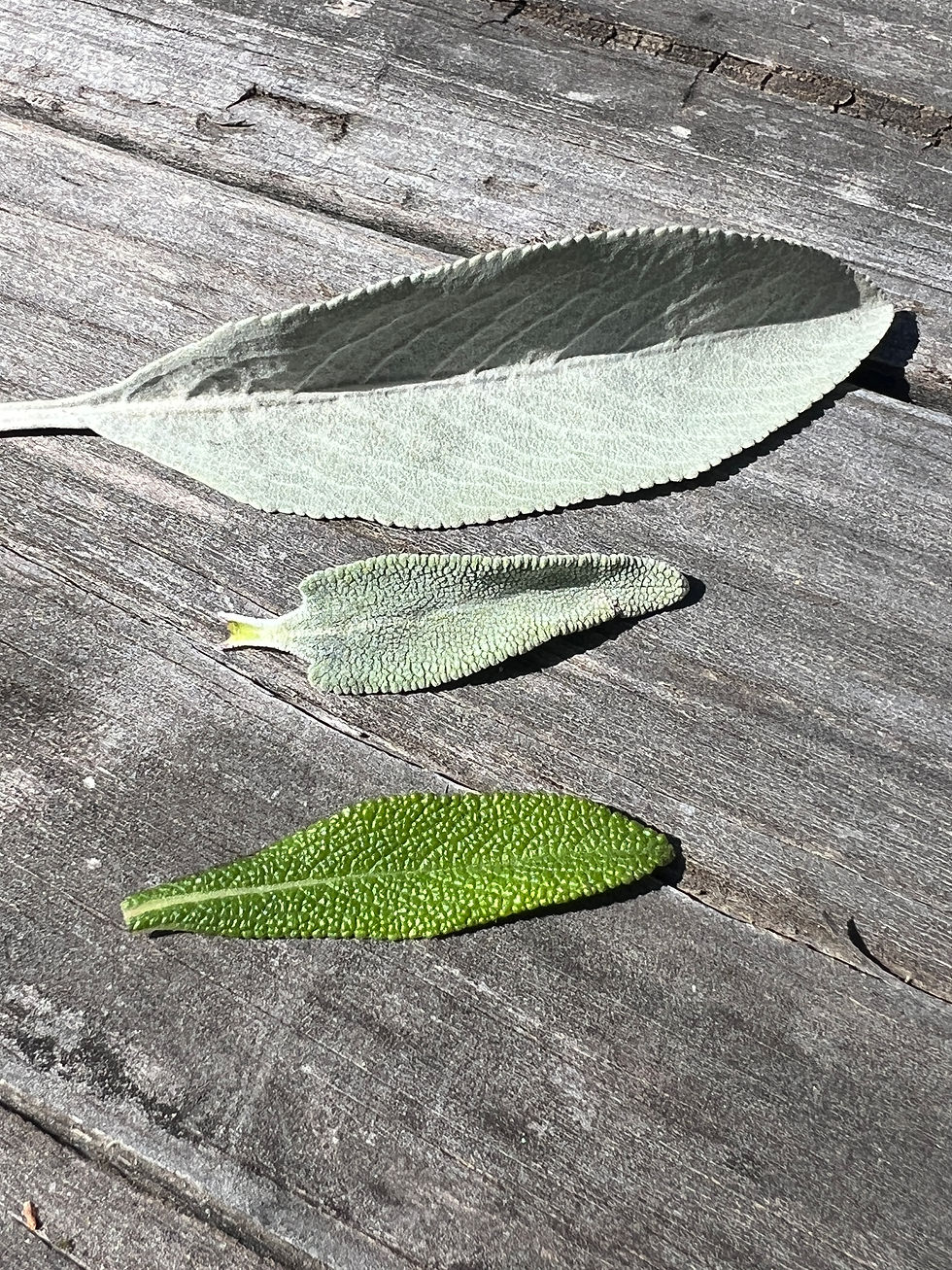Sensory Exploration: Sages (Salvia)
- Lauren Snyder

- Jun 2
- 5 min read
If you've ever been on a plant walk with me, you know that I love to explore plants through a multitude of sensory experiences. But, what does this look like beyond our walks together? How do I incorporate these experiences into daily life and daily plant learning. One of the best lessons, my first herbal teacher Sajah Popham instilled in me when it came to learning herbs was to "experience" the plant; over and over again, over time, with all your senses, in quiet contemplation...just experience it. It is part of the reason I am so passionate about growing many of the plants I work with; so that I can experience their existence from seed to harvest. Earlier this year, I did an exercise with three varieties of commo native Sage that I grow in my garden (White Sage, Purple Sage, and Black Sage). These three in particular, often present a bit of a challenge for the everyday observer when it comes to telling them apart. So, I spent the morning observing them, harvesting, smelling, tasting, and just journaling everything that came up; so that I could better understand their differences and I could better articulate those subtleties to others when we walked together.
I'd love to share some of those observations with you below. Enjoy!
White Sage (Salvia apiana)

White Sage is probably the most easily distinguishable, in part because of a sudden cultural obsession with it within the modern wellness industry. White Sage was catapulted to the top of the spiritual plant hierarchy as a purifying entity. Now, while I could easily argue the endless issues of cultural appropriation, over harvesting, illegal poaching, and over use of this plant (to get more info, check out Saging the World); I would like to steer away from that for a moment to discuss the nuances of the plant itself.
White Sage has large, thin, velvety leaves that often fold into a sort of hard shelled taco shape. The leaves are a silvery blue green color (literally think a light sage green). They bear a single middle rib with alternating raised veins alone the length of the leaf. In a healthy plant, the leaves and stems may even feel a bit sticky and resinous (this is thanks to its powerhouse of chemical constituents and essential oils). Some of the scent notes that I experienced when sitting with this plant were: -A sharp almost tangy scent that sits high in the nasal cavity
-It has a middle/top note quality to it (as opposed to the other two sages) -Its scent is by far the strongest and most long lasting of the three
Black Sage (Salvia mellifera)

Black Sage is one of my favorite local sages, because it is a powerhouse packed in a very unassuming package. Unlike White Sage, its leaves are much smaller and narrower. Unlike Purple Sage's showy purple flowers, black sage has much smaller flowers that are more are a more blue toned purple than the bright purple/pink in the Purple Sage. Black Sage leaves have a darker more bright green coloration and I describe their leaves as thicker and "juicier" than White Sage leaves. The veins on the top of the leaf indent into the thickness of the leaf creating more texture and definition that white sage (although not as much as purple sage, as we'll discuss shortly.) The veining on the underside of the leaf protrudes noticeably and the overall leaves are significantly smaller that the other two sages; and as you can see in the picture, very long and thin. Black Sage also has a powerful assortment of chemicals and oils that lend to it's known pain relieving properties and give it a scent almost as strong as White Sage.
Some of the scent notes that I experienced when sitting with this plant were: -A thick heavy scent that had a watery quality to it (almost like you could "smell" the hydration of the leaves)
-It had a hint of sweetness upon first exposure followed by a bitter undertone -It was not as sharp/tangy as the White Sage, but nearly as strong
Purple Sage (Salvia leucophylla)

Purple Sage is, what I consider, the most gentle of the three compared here. It has small thin elongated spade shaped leaves in a blue silver color similar to White Sage. However, unlike White Sage, Purple Sage leaves are very thick and almost velvety. There are many mottled indentations and significant vein protrusion on the underside of the leaf. I consider purple sage the thickest leaf of the three and it has an almost pillow like quality up close. However, the most distinct visual cue to identifying Purple Sage, is its brilliant bulbous purple flowers in spring/summertime that are eye catching at any distance.
Purple Sage flowers are among the showiest of our local sages (although, not discussed here, in my humble opinion, Hummingbird Sages are the reining queen of showy spring flowers!)
Purple Sage is not considered to be as strongly scented as the other two sages, which may be due to a lower level of terpenes and other chemical constituents.
Some of the scent notes that I experienced when sitting with this plant were: -A much softer and more neutral toned scent -The overall profile is similar to White Sage with a slightly more floral tone
-There is also the slightest hint of a bitter undertone after the initial smell

So, even though all three plants are a part of the plant genus Salvia and closely related; they all are incredibly unique and interesting.
Things get even more complex when you factor in seasons, growth cycles, reproduction, potential cross pollination, and ecosystem variations. I have seen quite a number of variations from plant to plant while out on the trail; so while these are in depth observations of my plants at home, they are just a starting point for building a deeper connection to this incredible collective of plants.
So, my invitation to you is this...next time you are out on the trail, take a few moments to sit and observe one single plant. See if you can dive deep into the subtleties and nuances of its leaves, its flowers, the stems, the seeds, etc. Take notes in a journal, draw pictures in a sketchbook, or take a million pictures on your phone. Then come home and explore those observations a little more. Keep a running tab of observations each time you see the same plant; and revisit it throughout the seasons. You will be amazed at how you suddenly begin to "know" it more intimately and your confidence with plant identification will grow!
Happy Observing!





Comments